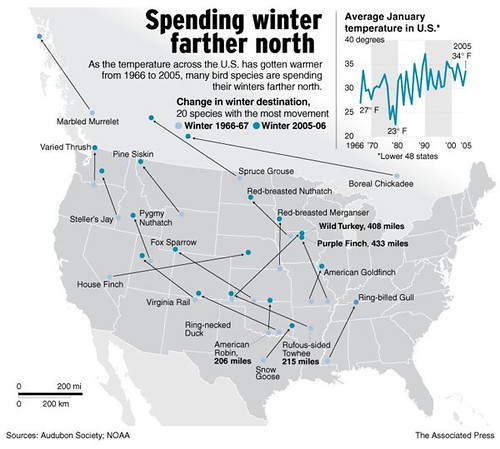tags: global warming, climate change, birds, ornithology, Audubon Society, webcast
The idea that global warming is not just about polar bears in the Arctic, but also about American Robins in our own backyards has captured people's attention. Nearly 60% of the 305 species found in North America in winter are on the move, shifting their ranges northward by an average of 35 miles. Audubon scientists analyzed 40 years of citizen-science Christmas Bird Count data -- and their findings provide new and powerful evidence that global warming is having a serious impact on natural systems. Northward movement was detected among species of every type, including more than 70 percent of highly adaptable forest and feeder birds.
The Audubon Society wants to be sure that you are the first to know about this disturbing phenomenon through a special, live webcast with Dr. Greg Butcher, the author of the groundbreaking report, Birds and Climate Change: Ecological Disruption in Motion [free PDF]. In this streaming webcast, Dr. Greg Butcher, the Audubon Society's Director of Bird Conservation, will give you an inside look into his groundbreaking report, live today (Friday, 20 February) at 1 PM EST/10 AM PST. This webcast will feature an interactive slideshow and presentation, followed by listener/participant questions and Dr. Butcher's answers. To hear and participate in this live webcast, you must register first (but it's free).
- Log in to post comments


"shifting their ranges northward by an average of 35 miles." over what time period?
Read the graph, Nick. It says winter 1966/67 to winter 2005/06.
I leave you to do the math.
What is so disturbing about a 35 mile change in range? In warmer years birds will venture further north, in cooler years they will not venture so far north.
Climate has varied forever. That is the nature of a chaotic system like climate. So what if the range drifts a bit north or a bit south at different times? I'd like one of these global warming alarmist scientists to tell us when in the history of the world has these ranges stayed perfectly uniform for any length of time.
The temperatures have been on the rebound, ie. getting warmer, ever since the last glaciation period about 15,000 years ago. There is no disputingthat fact. Back then, birds ranges were shifted thousands of miles south of their current ranges. I'd say that birds ranges very slowly shifting north is a much more desireable thing, and not at all alarming, compared to a massive 1000 mile shift to the south, which is possible should an ice age return.
Heat and warmth is actually a good thing for flora and fauna. Cold is not.
Yeah, my bad. I read it too fast :)
For some reason, can't register!
Tunderbar | February 20, 2009 11:49 AM
But only in the last 10,000 years - only in the longest period of relatively stable climate in the last 2.5 million years - has civilazation developed.
Not true. After the end of the last glaciation, global temperatures peaked 6,000-8,000 years ago. From then until about 1900, global temperatures were mostly stable, or even descending, with small variations. Since 1950, global temperatures have risen with increasing rapidity. See here. Note the warmth of 2004, not the warmest year on record, but nonetheless warmer than any of the variations in climate over the last 10,000 years.
When the last glaciation ended, global temperatures rose by about 10 C over about 5000 - 7000 years, about 0.015 - 0.02 C per decade. Yet even the most optimistic (that is, with the most agressive emissions cuts) projections for human-caused global warming show about 1.5 C warming over the next 100 years. That is about 0.15 C per decade, or 7 to 10 times as fast a warming as occurred at the end of the last glaciation. If little or nothing is done, global temperatures are likely to rise as much as 4 - 6 C in the next 100 years. That's about 0.4 C - 0.6 C per decade, or 25 - 30 times as fast as the warming that occurred at the end of the last glaciation.